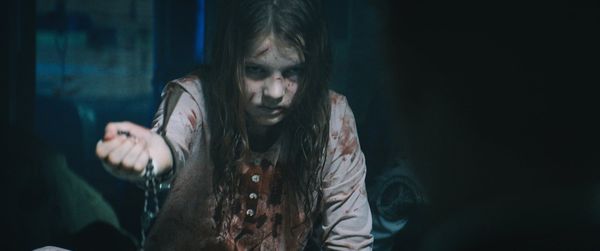Eye For Film >> Movies >> Prey For The Devil (2022) Film Review
Prey For The Devil
Reviewed by: Jennie Kermode

In the history of occult horror, few films have achieved lasting status, but 2010’s The Last Exorcism was one of them, marking out director Daniel Stamm as one to watch. This film, also known as The Devil’s Light, sees him return to the subject, and although the result isn’t likely to have the same impact, there’s still a lot to admire about this stylish piece of work.
From the outset, it has something of the cool visual flair of a Seventies thriller, though its heroine, Annie (Jacqueline Byers), is a thoroughly modern woman. She is also a nun, and if those two things seem to be at odds, well, that’s partly what makes it interesting. We learn early on that Annie’s mother was schizophrenic but also seems to have been possessed, and that Annie suffered violent abuse in childhood as a result. Her experiences have left her keen to develop the skills which will help her to fight demons, despite the fact that the rites of exorcism have been exclusive to men for over five hundred years.

As a nun, Annie is supposed to focus on support work, on care and healing, not to sneak into lectures on exorcism and fraternise with young priests, at least one of whom (Christian Navarro’s Father Dante) is inclined to gaze at her as if he has a crush. Her support work includes caring for people who have been referred to the institute where she works because they are possessed and nobody has been able to free them. If they can’t be treated there, the next stop is the Vatican, and as she discovers, most people sent there end up dying as a result of their condition. When the youngest of her patients, Natalie (Posy Taylor), is declared to be a terminal case, Annie is determined to intervene no matter what anybody says. An early success makes a big impression – but what is really going on?
Prey For The Devil lays its cards on the table early on. It is unashamedly a supernatural story, drawing on the rich conceptual framework developed over centuries by the Catholic Church. Its central questions revolve around the experience of a calling, the potential for miraculous action, and the dangers of the sin of pride, which could make it all too easy to fall prey to an adversary’s trickery. Annie must strive to strike a balance between the assertiveness needed to overcome sexism and reach her potential, and the inflated self-belief which demons might all too easily exploit.
Alongside this intellectual conceit is a display of spectacular and grisly exorcism effects which, lets face it, is what a lot of fans will really be here for. Because no time is wasted on debating the reality of possession, Stamm is able to get straight to it, and these sequences appear at intervals throughout the film. Despite Annie’s apparent talent, not all of them play out the way she expects. The balance of action/horror sequences and investigative drama keeps the film rattling along, whilst supporting performances from the likes of Virginia Madsen and Colin Salmon ensure quality.
Towards the end, the film begins to flag a little. It doesn’t deliver as much of a punch at the end as fans of Stamm’s earlier work might be hoping for, but there’s a great deal of interesting stuff along the way, especially in terms of the real lore and practice which it reveals in lightly fictionalised form. The acting is uniformly impressive, with Byers a capable lead, and as a director Stamm only gets better, whilst cinematographer Denis Crossan’s work is a treat. This may not be up there with the greats but it’s still a satisfying occult thriller with a lot to recommend it.
Reviewed on: 28 Oct 2022

















